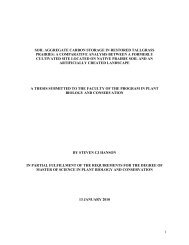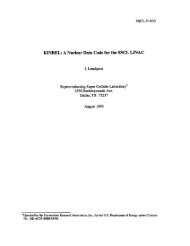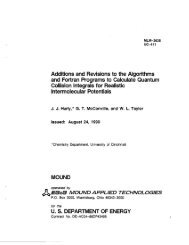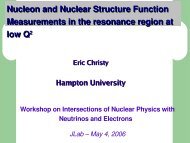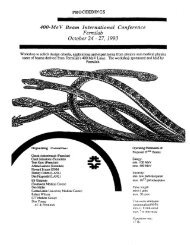Workbook
Workbook
Workbook
You also want an ePaper? Increase the reach of your titles
YUMPU automatically turns print PDFs into web optimized ePapers that Google loves.
51<br />
E-672 (Zieminski) StudyofHadronic Final States<br />
inAssociation with High Mass Dimuons<br />
Fermilab, IHEP/ Serpukhov (Russia), Illinois / Chicago,<br />
Indiana, Louisville, Michigan/Flint<br />
IStatus: Data AnalysisI<br />
The aim of the E-672 experiment is to study hadronic processes yielding<br />
vector mesons (p/ro, , J/"" ",')and high mass· dimuon pairs (the trigger) and<br />
associated particles. The experiment shares the MW beam line, magnetic<br />
spectrometer and calorimetry with the E-706 experiment. The dimuon detector<br />
is located downstream of the forward hadronic calorimeter and consists of a<br />
toroid magnet, six PWC's with three or four planes each, two scintillator<br />
hodoscopes used in the dimuon pretrigger and pretrigger and trigger<br />
processors.<br />
E-672 IS an open geometry dimuon experiment. The geometrical<br />
acceptance for dimuon pairs produced in hA collisions at 530 GeV/c is<br />
approximately 20% and has a maximum for Feynman x = 0.25. The physics<br />
goals, which all are related to experimental tests of Quantum<br />
Chromodynamics, include:<br />
(a) Production of X states by observing their radiative decays into J/",y with<br />
gammas either converting into e+e- pairs inside the target or observed in<br />
the LAC;<br />
(b) Production of b-quarks observed via their decays to J/", (inclusive and<br />
exclusive modes: J/",K, J/",K* and J/",KO);<br />
(c) Production of b-quarks observed via double semileptonic BB decays into<br />
like-sign dimuons;<br />
(d) General properties of the production of vector mesons (p/ro, , J/"" and ",')<br />
and Drell-Yan pairs<br />
- total and differential cross sections<br />
- gluon structure function of the incident hadron<br />
- production of associated charged and neutral particles<br />
- dependence on the inelasticity on the collision<br />
- the A-dependence of total and differential cross sections<br />
(e) J/", + nn spectroscopy (same for



